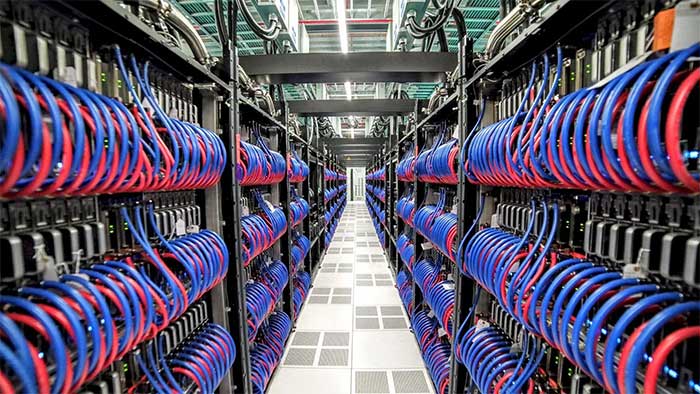These supercomputers are applied in various fields such as simulating nuclear missile tests, weather forecasting, climate research, and testing the computational strength of encryption.
Supercomputer is a massive system with computational power millions of times greater than conventional devices, designed to solve complex global problems. They are utilized in various fields such as simulating nuclear missile tests, weather forecasting, climate research, and testing the computational strength of encryption.
The list of the top 10 most powerful supercomputers in the world is extracted from the latest Top500 supercomputer ranking.
The Top500 project on supercomputers has been conducted annually since 1993 by renowned experts such as Jack Dongarra from the University of Tennessee, Knoxville; Erich Strohmaier and Horst Simon from the U.S. Department of Energy’s Oak Ridge National Laboratory; and Hans Meuer from the University of Mannheim. The rankings are typically published online in June and November or at the International Supercomputing Conference and the ACM/IEEE Supercomputing Conference.
The countries that own the most powerful supercomputers in the top 10 globally include the United States, China, Japan, Finland, and Italy.
1. Frontier (United States)

The world’s most powerful supercomputer, Frontier.
The Frontier system at the Oak Ridge National Laboratory in the U.S. became the first supercomputer to surpass one exaflop (one quintillion calculations per second) last year.
This supercomputer was developed by the U.S. Department of Energy. It dethroned the Fugaku system from RIKEN’s Center for Computational Science in Japan.
In benchmark tests, Frontier achieved 1.19 exaflops, equating to 1.19 quintillion calculations per second. The system is built on HP’s CrayEX platform and contains 9,400 AMD EPYC 64C 2 GHz processors along with 37,000 AMD Instinct 250X GPUs, housed in 74 racks, each weighing over 3,600 kg.
2. Fugaku (Japan)
Previously, Fugaku held the title of the world’s most powerful supercomputer from 2020 to 2021. This system, developed through a collaboration between Fujitsu and the RIKEN Institute, achieved a speed of 442 petaflops (442 quadrillion calculations per second) and was used for Covid-19 research in 2021. This supercomputer is widely used in various industries.
3. Lumi (Finland)
Lumi is the most powerful supercomputer in Europe and ranks third in the world, achieving a computational capacity of 309 petaflops.
4. Leonardo (Italy)
This supercomputer located in Bologna has a computational power of 238.7 petaflops. The system utilizes Intel’s Xeon Platinum 8358 32C chips along with Nvidia’s A100 and HDR100 processors. Leonardo has been operational since November 2022, with a construction cost of $240 million. The operating software is managed by Intel and Nvidia.
5. IBM Summit (United States)
As large as two tennis courts, the Summit supercomputer at Oak Ridge National Laboratory has an average performance of 148.6 petaflops, peaking at 200 petaflops. IBM’s system weighs a total of 340 tons, equipped with 9,216 IBM Power9 22-core processors, 27,648 Nvidia Tesla V100 GPUs, and requires 15,000 liters of water per minute for cooling.
This supercomputer was ranked number one in the world in 2018 and 2019.
6. IBM Sierra (United States)
IBM Sierra ranks sixth with a computational capacity of 94.6 petaflops. Sierra combines chip processors provided by IBM and Nvidia and is located in Livermore, California. Sierra’s highest rank was second place in 2018 and 2019.
7. Sunway TaihuLight (China)
Sunway TaihuLight has a computational power of 93 petaflops. This system is housed at the National Research Center of Parallel Computer Engineering and Technology (NRCPC) in Wuxi. It utilizes 40,960 SW26010 64-bit RISC processors based on the Sunway architecture, with each chip containing 256 processing cores and an additional four auxiliary cores for system management, bringing the total number of processing cores to 10,649,600 across the system.
8. Perlmutter (United States)
Perlmutter achieves a computational power of 70.87 petaflops, using AMD chips combined with Nvidia technology. This supercomputer is located at the U.S. Department of Energy’s National Energy Research Scientific Computing Center (NERSC) and is utilized for nuclear reaction simulations, climate forecasting, and biological research.
9. Selene (United States)
Selene has a power of 63.46 petaflops and was built in 2020 by Nvidia to aid in Covid-19 research, located at Nvidia’s headquarters in Sunnyvale, California. The system primarily uses AMD and Nvidia chips.
10. Tianhe-2A (China)
Tianhe-2A is located at the National Supercomputing Center in Guangzhou. The system was developed by a team of 1,300 Chinese scientists and engineers and previously held the title of the world’s most powerful supercomputer in 2013, 2014, and 2015.





















































